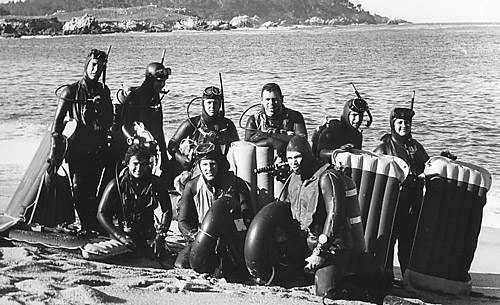|
 |
|
 |
The History of the UC Berkeley Scientific Diving Program
|
 |
The foundation for Scientific Diving Training at UC Berkeley was laid in 1961 by seven divers with varied diving backgrounds on campus. One of these early seven, a Berkeley Zoology lecturer, Lloyd F. Austin, would later become UC Berkeley's appointed Diving Safety Officer overseeing the training and certification of 760 divers until his retirement in 1996.
In 1961 Vice Chancellor Ted Chenowith evaluated and certified these seven dive enthusiasts and created a fledgling diving program modeled after the Scripps Institute of Oceanography. The Chairman of the Diving Control Board was Professor of high altitude physiology, Doctor Nello Pace. The acting Diving Safety Officer (DSO) was Zoology Professor, Raymond Ghelardi. The original seven graduate student divers swelled to about 27 in number over the next few years. Under the auspices of the diving control board and adhering to a Diving Safety Manual modeled after early manuals at Woods Hole and Scripps these divers were deployed to do underwater surveys for the construction of the Bodega Marine Lab, a Berkeley entity at the time. Interest in diving continued to grow and in 1966 the Diving Control Board decided to take on the challenges of diver training on campus. Lloyd Austin was appointed the Diving Safety Officer and tasked with training. The first training class followed in 1967 with, serendipitously, SEVEN students. The following year's class was twice as large so Lloyd asked two students from 1967, Gay Little and Ron Roth, to help keep a watchful eye on the class. Lloyd maintained this model of class graduates assisting with training throughout his tenure as DSO. It was a model that fostered an unmistakable camaraderie within the group and a commitment to maintaining high standards of Diving Safety in diver training.
These safety standards reflected the altruism of two administrators in the Chancellor's Office, Director of Environmental Health and Safety, Larry Smelzer, and Vice Chancellor Ted Chenowith. It was here in the Chancellor's office that the Division of Diving Control was officially established in 1968-69. Henceforth the Division would report directly to the Chancellor.
Training flourished into the 1970s at which time a burgeoning commercial diving industry threatened the future of Scientific Diving. Commercial diving was regulated by the Department of Labor, OSHA and regulation was strict. Commercial operations were required to have decompression chambers and technicians on-site at all dives. By 1976 the campaign by commercial divers and their attorneys to extend the same OSHA requirements to the Scientific Diving community met with success in OSHA and rallied great resistance within the Academic Community. The high cost of commercial compliance spelled the end of diving for research purposes and a coalition of Diving Safety Officers formed to resist the regulation. This body was a precursor to the American Academy of Underwater Sciences (AAUS). On behalf of the coalition, Dick Bell at Davis, and Lloyd Austin at Berkeley petitioned OSHA for an exemption. After five years and many trips to Washington, D.C. the academic coalition successfully demonstrated that with its high training standards, rigid medical record keeping and dive log maintenance, self regulation could continue without jeopardizing diver safety. OSHA granted the exemption from Commercial Diving Standards and the self regulating entity of Scientific Diving was official.
In all, an estimated 130,000 dives were logged by divers under the auspices of the Berkeley Campus between 1961 and 1996. Only 4 serious injuries were reported; one broken leg in the surf zone and 3 ruptured ear drums all of which healed and the patients returned to diving. There were no reported decompression injuries.
Today the graduates of the UC Berkeley Diving Program are active in fields of Marine Conservation and Policy, Marine Engineering, Marine Archaeology, Zoology, Phycology, just to name a few. The combination of physically rigorous diving training and in-water scientific methodology were hallmarks of the Berkeley Diving Program. The training course prepared divers to successfully conduct all types of underwater research. From the setting up of surveys to videography and mapping, and even the discovery of new plant and animal species, the divers trained at UC Berkeley are advancing our understanding of Ocean Ecosystems throughout the World.
—Robin Hathaway
|
|
|
|
|
 |
|
 |
|


